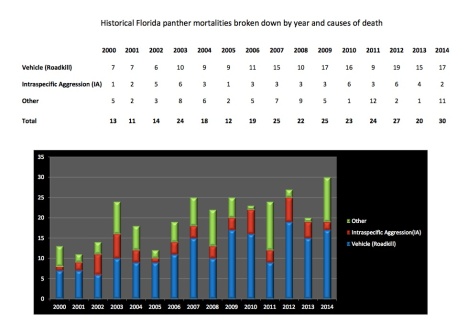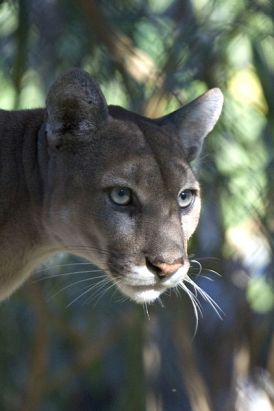Staff Report
FRISCO — Panther deaths in Florida climbed to a record level in 2014, as the wild cats continue to succumb to collisions with vehicles on highways in southwest Florida.
In all, 30 panther deaths were reported by the Florida Fish and Wildlife Conservation Commission this year, topping the previous record of 27 deaths tallied in 2012. More than half of this year’s deaths were the result of collisions with vehicles.
Panther mortality this year could represent as much as one-fourth of the entire population, which the Florida Fish & Wildlife Conservation Commission estimates at between 100 and 180 animals. The reason for this wide variation is that the number of cats monitored through radio collars has steadily declined.
“The management of the Florida panther is biology by body count,” said Jeff Ruch, director of Public Employees for Environmental Responsibility. “The true condition of the Florida panther today remains what biologists call a ‘SWAG’– a scientific wild-ass guess,” said Ruch, whose group watchdogs public agencies.
The Florida wildlife commission says 32 panther kittens were born this year, but considering that the low survival rate, it’s likely that panther mortality will exceed recruitment this year.
The Florida panther is the only known population of North American cougar east of the Mississippi. While cougars once had the broadest distribution of any terrestrial mammal in the Western hemisphere, Florida panthers today are confined to only a small fragment of their former range in southwest Florida.
The latest mortality numbers reflect this cramped vestigial habitat – 27 of 30 deaths occurred in just three counties (Collier, Lee and Hendry) and the majority of which (17) were caused by vehicles.
Radio telemetry is the principal means of tracking elusive panthers, as well as determining habitat needs and the dispersal of cats seeking new territory. Of the 30 panthers that died this year in the wild, only 7 had radio collars. The latest FWC reports only 16 females are currently radio-tracked, and the agency collared only ten cats in the year prior to July 2014.
The Florida panther has been listed as an endangered species for more than 40 years. The long-term prognosis for the recovery of the Florida panther is bleak, however, largely because the available habitat will continue to shrink.
According to PEER, the rare animals face an uncertain future in Florida because:
- Florida continues to approve sprawling new developments in panther habitat;
- The U.S. Fish & Wildlife Service has resisted legal efforts to force it to designate critical habitat for the Florida panther, as has been designated in recovery plans for hundreds of other species; and
- Prime panther areas, such as the vast Big Cypress National Preserve Addition Lands, are being opened up to off-road vehicle traffic.
“In South Florida, the panther literally is a speed bump to sprawling development,” Ruch said. “Many believe we have already reached the tipping point where a viable population of Florida panther can no longer exist in the wild and the future of this alpha-predator is as a zoo species.”
2014 FWC panther report:












No comments:
Post a Comment